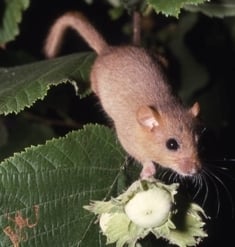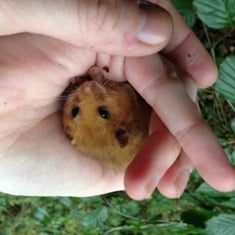Dormice can be a serious business
17th November 2014

James Field, Ecologist & Environmental Planner talks to us about the the lengths to which we go to ensure that no dormice are accidentally harmed in the course of our business.
Did you know that the South West is a stronghold for one of the country's most charismatic and elusive wild animals - the dormouse? Even so I'm willing to bet that most of you reading this blog will have never seen one.
I mean it's not exactly like they're easy to spot. They only come out after dark and then spend all their time hiding in dense woodlands, scrub and hedgerows. And for practically half the year they hibernate and don't bother getting out of bed at all!
Now I'm not telling you this to gloat that, through my work, I've been lucky enough to get up close and personal with a few dormice but because I'd like to tell you about a side of South West Water that you might not be aware of: the lengths to which we go to ensure that no dormice are accidentally harmed in the course of our business.
We do this partly because it's an integral part of South West Water's commitment towards protecting and enhancing the South West's natural environment (as shown through innovative projects like our Upstream Thinking programme). When it comes to dormice, however, we also have another incentive. You see they're a protected species and it's illegal to kill or injure a dormouse or to destroy their habitat. Even just 'disturbing' them can be an offence and anyone found guilty of doing so can face massive fines or even be sent to prison.
So for an organisation looking after extensive water and sewerage systems throughout the countryside and towns and villages of the South West, dormice can be a serious business. How do we make sure that we don't accidentally harm any when we're planning new pipelines or carrying out essential repairs to treatment works? How do we protect a tiny animal that is, to all intents and purposes, practically invisible to most people most of the time?
That's where I and my colleague Kate come in. Our job is to provide ecological advice and support to South West Water's engineering teams, to make sure that our essential engineering projects are completed on time and to budget whilst also meeting our ethical and legal obligations to protect dormice.
We do this in a number of ways. At its simplest level, if we think that certain habitats or features might support dormice we'll advise the engineers to try and avoid those areas. If we need to cross any hedgerows we might use special rigs that allow us to feed pipes beneath hedgerows without causing any damage to the hedge or any creatures that might be living it.
There are occasions though when we have no choice but to disturb the sorts of habitats where dormice might be found. When this happens we need to find out for sure whether or not they're there before we proceed:

If the area to be affected is small we might carry out a detailed finger-tip search to see if there are any nesting or hibernating dormice present. For larger areas where this is impractical we will usually hide special tubes in the vegetation and then monitor them to see if any dormice build one of their distinctive woven nests in any of them. If we find a nest we know we've got dormice and if we don't we can be pretty sure that there aren't any. This can only be done over the summer though so it needs careful planning. Another way of finding them is to look for the remains of hazelnuts they've nibbled. This has the advantage that it can be done during the winter months but the disadvantage is that an absence of nuts can't usually be relied upon to prove an absence of dormice.
So what do we do if find dormice and we still need to carry out work? Under such circumstances we will usually need to apply for a special licence to make sure that we don't break the law. Licences will only be issued if it can be shown that there will be no overall harm to the dormouse population and as such it will contain strict conditions about how and when work has to proceed and will often require us to undertake habitat creation or enhancement to compensate for the disturbance.
So all in all a lot of effort and care goes into making sure that no dormice are harmed whilst providing water and sewerage services to the people of the South West. And of course dormice are just one of many protected species that we consider. There's also bats, badgers, birds, snakes, lizards, otters, salmon, water voles, great crested newts, marsh fritillary butterflies and many, many more...
For further information please contact:
Press Office
South West Water
www.southwestwater.co.uk/contactus
